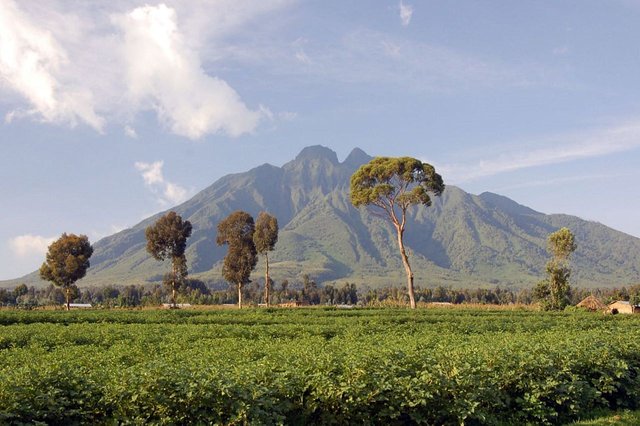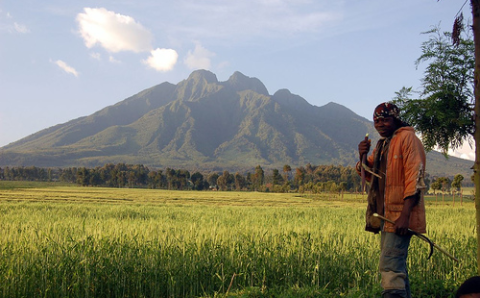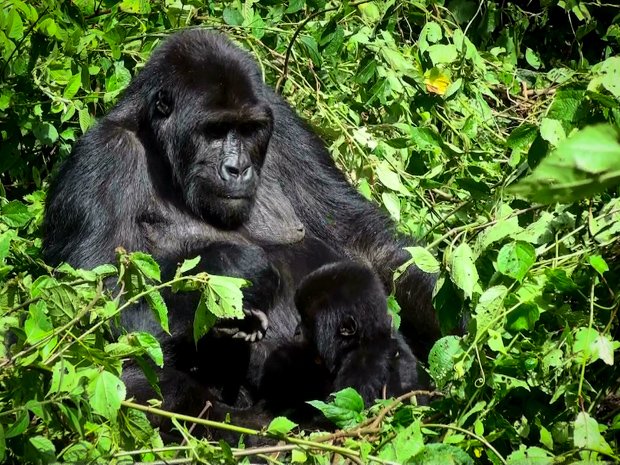Wonders of nature. Virunga Mountains

Eight volcanoes hide their peaks in the clouds on the border of three East African states.
If you look from a distance, the peaks of the Virunga mountains, hidden by a cloudy haze, amaze with their size. Eight volcanoes, stretching for 58 km, make up the ridge of Virunga. Six of them, located in groups of three, extinct and long silent, and two more, standing together on one end of the ridge — acting, all the time smoking and threatening another eruption.
Nyamuragira, which means "commander", is one of the most active volcanoes in the world. The Europeans first saw it operating in 1894, and since that time there have been several eruptions through the cracks on its slopes. In 1938-1940 the lava flowed from the slopes of the volcano to the lake Kivu, located 24 kilometers from it. The current lava shone like coal in the stove, and huge clouds of steam rose above the place where the lava met the lake's water. The loss of such a large amount of lava led to the fall of the top of Nyamulagira, which caused a massive crater about 2 kilometers in diameter.
The impressive volcano is also crowned by the active volcano Nyiragongo. In 1977, its almost right cone cracked in five places, and then lava spilled out, burning everything in its path.

The lake, spoiled by lava
Streams of lava from Virunga influenced the surrounding landscape. These mountains are located on the western branch of the East African rift system. Once the rivers flowed north to the Nile, but the lava flows from the volcanoes blocked their way, which resulted in the formation of Lake Kivu. Its banks are severely rugged, and many consider the lake the most beautiful in Africa. However, it can become a time bomb. Carbon dioxide seeps through the bottom of the lake and accumulates in the lower layers of the water, falling into a trap due to enormous pressure. Similar conditions developed in Lake Nyos in Cameroon, and in 1986 a toxic cloud of gas suddenly burst from the water and spread over densely populated valleys, causing the death of more than 1,700 people.
Near Lake Kivu, the consequences may be even worse, because under the influence of bacteria carbon dioxide is converted into methane. Human activities can lead to a large amount of gas rising to the surface. And contact with any open flame will cause a monstrous explosion that will scorch everything around.
Other volcanoes of the Virunga Range have long since died out. The highest mountain, Karisimbi (4507 meters), got its name from the word "nsimbi", which means "white shell of the cowry", because of the snow that often covers its top. The slopes of the nearby Bisoka Mountain serve as a habitat of mountain gorillas. Sabino, located near the eastern part of the ridge, is crowned with several sharp peaks, at the highest of which the borders of Rwanda, Uganda and Zaire converge.

Currently, most of the foot of the mountains is cleared for agricultural land, but something still remains of the old forest. Above are dense thickets of bamboo, and even higher is an open space with creeping trees, shrubs and glades covered with grass. Above 3,000 meters grow giant forms of heather, lobelia and a ragwort, and for a mark of 4000 meters only mosses, grasses and lichens can survive. In such diverse vegetation live 180 species of birds and more than 60 species of mammals, including leopards, viverra, hyenas and jackals, as well as buffaloes, shrubby wild boars, elephants and wood damans.
The forests of the Virunga are also the last resort of mountain gorillas. During the 1960s and 1970s, their numbers dropped from 400-500 to about 250 individuals. Gorillas could not stand competition with livestock, they were caught in large numbers for zoos, and poachers were killed to sell their heads and hands to tourists. For the first time attention to the problem of their survival was attracted by the American Dian Fossey, a doctor by profession, who previously worked with disabled children.
In 1967, Fossey settled in Rwanda on the slopes of Mount Bisoke and for 18 years studied gorillas in direct contact with them. Possessing endless patience and curiosity, she was able to win their trust. Sometimes she spent whole days crawling on all fours in a rain-drenched forest and in all imitating gorillas: she pretended to eat plants, it itches. She even had to beat herself in the chest and roar. After three years of working with them, she achieved significant success. Pretending to chew some plant, she reached out her hand to the gorilla, and the animal touched her fingers to her hand — this is the first known case when a wild gorilla touched a man.
The Case of Life
In order to protect these animals by international environmental organizations, the "Mountain Gorilla" project was created. The goal of the project was further study of gorillas and the development of tourism, which should create jobs and reduce poaching. Fossey did not approve of this plan — she wanted to patrol the territory with the right to shoot poachers caught at the crime scene.
At the end of 1985, she was killed by an ax. Fossey was buried not far from her hut in the mountains, but the work of her life began to bear fruit, and now the number of mountain gorillas in Virunga is gradually increasing.

Congratulations! This post has been upvoted from the communal account, @minnowsupport, by Mamasetta from the Minnow Support Project. It's a witness project run by aggroed, ausbitbank, teamsteem, theprophet0, someguy123, neoxian, followbtcnews/crimsonclad, and netuoso. The goal is to help Steemit grow by supporting Minnows and creating a social network. Please find us in the Peace, Abundance, and Liberty Network (PALnet) Discord Channel. It's a completely public and open space to all members of the Steemit community who voluntarily choose to be there.
Resteemed your article. This article was resteemed because you are part of the New Steemians project. You can learn more about it here: https://steemit.com/introduceyourself/@gaman/new-steemians-project-launch